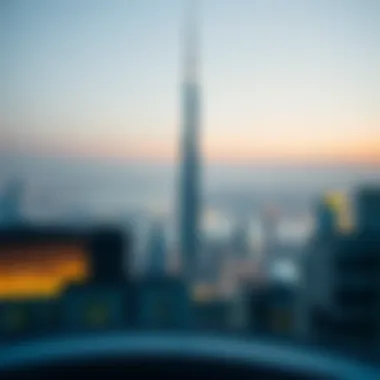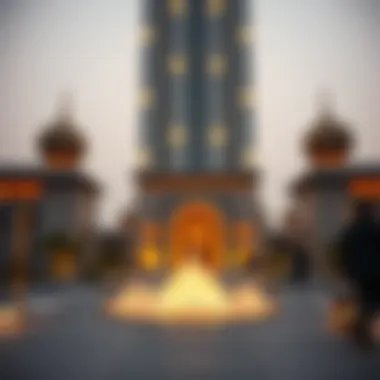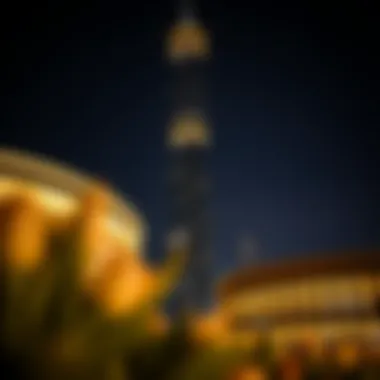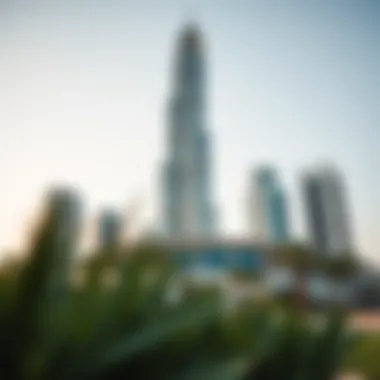Exploring the Pearl Tower: Architectural Marvel in Dubai


Intro
The Pearl Tower emerges as more than a simple architectural structure in Dubai; it's a living narrative of the city’s transformation, a fibrosis of modernity stitching together the Past, Present, and Future. As the dazzling sunlight dances off its reflective surfaces, this landmark embodies ambition and aspiration. Designers and architects looked to unify form and function in a way that both dazzles the eyes and serves practical needs.
Uniquely crafted, the Pearl Tower serves not only as a point of interest but as a powerful symbol of the cultural identity that continues to evolve in Dubai. From the lavish waterfront views to innovative design elements that make it stand out against the city's skyline, the Pearl Tower captures both local heritage and international influence, thus representing a crossroads of history and futuristic vision.
In this article, we will delve into various facets of the Pearl Tower—from its architectural ingenuity, the complexities of its construction, to its ripple effects on the local real estate ecosystem. Expect a close look at market trends, investment opportunities, and the significance of this impressive glass structure in shaping Dubai's future. Buckle up, as we take a deep dive into what makes the Pearl Tower a true icon of architectural splendor.
Prologue to the Pearl Tower
The Pearl Tower is more than just a tall building in the skyline of Dubai; it embodies the rapid growth and advancement of urban architecture. It illustrates how the city integrates modernity with tradition while becoming a global icon and hotspot for real estate investment. This section emphasizes the Pearl Tower’s significance from various angles, including its historical background and the vision that led to its creation. These elements provide context that helps readers appreciate its impact on architectural trends and local culture.
Historical Context
The Pearl Tower doesn't just rise into the sky; it rises from the history of Dubai, a city that has transformed from a modest fishing village into an international metropolis. This rise is firmly rooted in mixed influences, notably the wealth that oil discovery brought, propelling Dubai into a new era. Construction started in the early 90s and was completed by the late 2000s, a period characterized by rapid change and innovation.
The tower's naming draws from the region’s pearl diving heritage, a nod to the past amidst the glitz of modernity. Historical landmarks, such as Al Fahidi Fort, and traditional market areas are reminders of a simpler life before skyscrapers became the norm. The Pearl Tower mirrors this blend of old and new, representing the city’s aspirations as it strived to become a world-class destination.
Purpose and Vision
The purpose of the Pearl Tower goes beyond being a mere building; it serves several critical functions that align with Dubai’s strategic vision for urban development. It was designed as an observation tower and a mixed-use space, housing commercial offices, restaurants, and leisure activities. This multifaceted approach demonstrates the intention to create a hub where business and leisure intersect.
Visionaries behind the Pearl Tower sought to create more than just a physical structure. They aimed to contribute to Dubai's reputation as an architectural wonder and a thriving economy. This was dictated by the need to attract international investors and tourists while delivering a sense of community through multiple public spaces and amenities.
The Pearl Tower is, therefore, emblematic of Dubai’s relentless pursuit of innovation while preserving its cultural roots. Through this careful balance, the Pearl Tower stands tall—both physically and symbolically—as a testament to what Dubai has achieved and what is still to come.
Architectural Design and Features
The architectural design and features of the Pearl Tower are not just about aesthetics; they embody a narrative that intertwines ambition with innovation. This landmark stands tall as a beacon of what modern Dubai represents—a fusion of aspiration and cutting-edge design. The significance of these features extends beyond their physical manifestation; they resonate with the economic and social pulse of the city, drawing in investors, tourists, and residents alike.
Inspiration Behind the Design
The design of the Pearl Tower draws inspiration from both local culture and global architectural trends. Essentially, it mirrors the shape of a pearl in an oyster, symbolizing Dubai's growth from a humble fishing village to a luxurious metropolis. Architects sought to reflect the spirit of the Arabian Gulf, encapsulating the essence of its marine heritage. The structure’s swirling lines and curves echo the fluidity of water, creating a sense of movement amidst the rigidity of traditional architectural forms.
Key Characteristics
Material Selection
Material selection plays a pivotal role in the construction and longevity of the Pearl Tower. The use of high-grade steel and glass is prevalent throughout the tower, giving it an elegant yet robust appearance. Steel offers the necessary strength to withstand high winds, while glass provides breathtaking views of the cityscape. This combination is not merely functional; it also enhances the aesthetic appeal, cladding the tower in a shiny, reflective surface that catches the sun, creating a brilliant spectacle during the day.
One major advantage of using glass is its ability to invite natural light into the interiors, creating open, airy spaces that make working or visiting the tower a pleasurable experience. However, this choice also presents challenges; maintaining the structural integrity of the glass façade requires continuous care and cleaning, particularly in an environment subject to sandstorms.
Height and Structure
Standing at towering heights, the Pearl Tower redefines the skyline of Dubai. At a height of roughly 300 meters, it holds the record as one of the tallest structures in the city. The height is not just for show; it plays a critical role in maximizing the view and enhancing visibility from various points across the city. The central column structure supports various observation decks and facilities, emphasizing functionality alongside grandeur.
The unique feature of its height lies in the strategic placement of observation decks, providing panoramic vistas of the surrounding sea and city. This height is advantageous for drawing tourists and establishing the tower as a must-visit attraction. However, such elevation brings its own set of challenges, including construction logistics and safety measures during high winds, which need thorough planning and expertise.
Lighting and Aesthetics
Lighting and aesthetics are integral to the overall appeal of the Pearl Tower, especially at night when it transforms into a dazzling light display. The architectural design incorporates advanced LED technology, allowing for dynamic light shows that can be synchronized with various events, further enhancing its status as a cultural icon.


Designers have focused on creating a visual impact, where evening illumination highlights the tower’s unique architectural features, turning it into a stunning landmark against the night sky. The aesthetic aspect of lighting also provides safety, guiding visitors and ensuring visibility.
Nonetheless, it’s vital to balance aesthetic lighting with energy consumption. The aim is to maintain an environmentally conscious approach to sustain Dubai’s journey towards sustainability while still captivating audiences.
"The Pearl Tower stands as a symbol of 21st-century architecture, blending sheer modernism with cultural elements."
In summary, the blend of unique inspirations, thoughtful material choices, significant height, and intentional lighting makes the architectural design of the Pearl Tower a focal point in Dubai’s urban narrative. Its features serve not only to dazzle the eye but also to encapsulate the spirit of a city committed to progress and innovation.
Construction Process
The construction process of the Pearl Tower is pivotal not just for the edifice itself but for understanding its significance in the broader context of Dubai's architectural evolution. This section delves into the timeline of development, challenges faced during the construction, and how these factors collectively influenced the tower's notable stature in Dubai's skyline.
Timeline of Development
The journey to erecting the Pearl Tower began in the early 2000s, amidst Dubai's rapid infrastructural expansion. From conception to completion, the timeline spanned approximately three years, culminating in its grand opening in 2009. Understanding this progression offers insights into the planning, labor, and resources required to transform an ambitious design into an iconic landmark.
Key milestones in this timeline include:
- Initial Planning: Conceptualization of the tower was initiated in 2005, focusing on innovative architectural designs and potential market impact.
- Groundbreaking: This momentous occasion took place in late 2006, marking the start of physical construction.
- Structural Completion: By late 2008, the structure reached its maximum height, a feat achieved by implementing advanced construction techniques.
- Final Inspections and Public Opening: In early 2009, thorough inspections ensured safety and compliance, followed by the official opening ceremony that attracted considerable attention.
This timeline encapsulates a brief yet intense period where the Pearl Tower was envisioned and realized against a backdrop of ambition and growth.
Challenges Faced
Constructing such a colossal structure is seldom a walk in the park. Various obstacles emerged during the construction phase, each presenting unique challenges that required adept solutions. Understanding these hurdles sheds light on the complexities involved in managing large-scale projects.
Technical Obstacles
Technical obstacles played a significant role in the construction of the Pearl Tower. One of the core issues involved ensuring structural integrity while navigating the intricate architectural designs. Given the tower's sprawling height and unique shape, maintaining stability required innovative methods of engineering. Some notable aspects include:
- Engineering Feasibility: The design called for a mix of pointed and rounded forms, thus necessitating advanced structural calculations to prevent potential collapse.
- Material Use: Choices needed to maximize strength without compromising weight. As such, high-grade concrete and specialized steel reinforcements were employed.
Despite these difficulties, the innovative measures adopted created a safer environment and aligned perfectly with the ambitious goals set for the architectural marvel.
Weather Considerations
Weather considerations also heavily influenced the construction timeline and techniques. The stark desert climate of Dubai posed unique challenges that the construction teams had to navigate. Among the points of concern were:
- Temperature Extremes: The scorching heat often complicated scheduling and work hours, which needed to be adjusted to ensure worker safety without hindering progress. This made planning vital.
- Sandstorms: Occasional sandstorms hindered visibility and site safety, which in turn affected workflow. Safeguarding the machinery and materials became essential.
On a brighter note, these challenges spurred practical innovations and adaptations in construction methodologies, setting precedents for future projects in similar climates.
Supply Chain Issues
Supply chain issues present another layer of complexity in the construction process. Rapid demand for construction materials often stretched the capabilities of existing suppliers. Key characteristics of these challenges include:
- Material Shortages: Sourcing high-quality materials became a pressing challenge, impacting timelines. The necessity for prompt procurement forced project managers to explore alternate sourcing strategies, including international suppliers.
- Logistical Delays: Transporting materials over long distances added layers of complexity; efficiency became crucial to avoid these setbacks. Understanding the logistics behind such a massive build helped the developers streamline processes for better productivity.
Efficiently tackling these issues resulted in improving overall project management techniques, enriching the knowledge base for future projects.
The Pearl Tower’s construction journey represents a microcosm of modern engineering feats, illustrating how visionary designs can push the boundaries of what is architecturally possible. The challenges faced not only shaped the tower itself but also provided invaluable lessons for upcoming developments in Dubai and beyond.
As the Pearl Tower stands tall against the skyline, its construction process serves as a narrative of persistence, ingenuity, and unwavering ambition.


Impact on the Real Estate Market
The Pearl Tower has made waves in Dubai's real estate landscape since its completion. Its towering presence does not just serve as a pinnacle of architectural ingenuity, but it also acts as a catalyst for real estate dynamics in the vicinity. Understanding the implications of the tower on the market goes beyond mere statistics; it touches on the shifts in community perception, investment opportunities, and urban development strategies in a city that is always evolving.
Market Trends Post-Completion
After the Pearl Tower was completed, the local real estate market experienced notable fluctuations. Investors began to perceive the area around the tower as a prime spot, increasing demand for luxury apartments and commercial spaces.
- Increased Demand for High-End Properties: With the Pearl Tower as a glittering centerpiece, upscale developments around it gained popularity, attracting affluent buyers looking for a slice of luxury living.
- Rise in Property Prices: As demand surged, property prices followed suit, reflecting a heightened valuation of real estate in the shadow of the Pearl Tower. Such dynamics often create a ripple effect, pulling in more developers to the area.
Influence on Surrounding Areas
The emergence of the Pearl Tower has been transformative, catalyzing a greater interest in the areas surrounding it.
Property Values
When talking about property values, the influence of the Pearl Tower can’t be overstated. The moment it lit up the Dubai skyline, it cast a new glow on local real estate values.
- Appreciation of Nearby Properties: Properties near the Pearl Tower have seen a significant increase in value, appealing to both investors and homebuyers pursuing prestige.
- Luxury Market Indicator: This chic tower acts as a yardstick for luxury market trends. As it remains an icon, high-value real estate continues to burgeon nearby, attracting buyers keen on high-end living.
Commercial Opportunities
The Pearl Tower has also been a boon for commercial prospects in its vicinity. Businesses are not overlooking the foot traffic that a landmark like this can generate.
- Increased Retail and Office Space: Entrepreneurs and businesses vying for visibility look to secure leases in sought-after locations around the tower. This results in a bustling commercial hub, ideal for retail and office spaces.
- Sustained Economic Growth: The constant influx of tourists and locals creates an environment ripe for commercial expansion. Businesses that capitalize on this can thrive, further enhancing the economic vitality of the area.
Neighborhood Development
As the Pearl Tower enhances the local skyline, it has become a driving force for neighborhood development. Communities are reshaping themselves around this iconic structure.
- Infrastructure Improvements: The tower has spearheaded significant investments into infrastructure in its vicinity. New transportation links, road upgrades, and enhanced public services have been initiated to cater to the growing populace.
- Community Engagement Initiatives: Local governments have taken cues from the tower’s popularity, often organizing community events and initiatives to foster engagement among residents and businesses. Such initiatives foster a communal spirit, thus enriching the neighborhood’s appeal.
Overall, the Pearl Tower stands not just as a marvel of engineering but also as a transformative force within Dubai’s real estate market. Its significance transcends physical dimensions, influencing values, commercial viability, and community cohesion for years to come.
Cultural and Social Significance
The Pearl Tower holds more than just its striking architectural features; it carries profound cultural and social importance that resonates across the diverse fabric of Dubai. It is a mirror reflecting the aspirations, identity, and dynamism of a city that has become synonymous with luxury, innovation, and cultural synthesis. This section will explore how the tower signifies modernity and community connection, weaving itself into the daily lives of people both locally and beyond.
Symbol of Modern Dubai
Standing tall against the ever-changing skyline, the Pearl Tower is often regarded as a symbol of modern Dubai. It embodies a city that strides confidently into the future, showcasing what can be achieved when ambition meets creativity. This striking structure, with its pearl-like design, goes beyond aesthetics; it represents the values of progress and cultural evolution.
After witnessing rapid transformation from a humble trading post to a global metropolis, the Pearl Tower encapsulates that narrative. Its architectural brilliance not only enhances Dubai's skyline but also draws tourists and investors alike, forever changing the perception of what a city can aspire to be. As folks flock to see the tower, they are not just witnessing a piece of art; they are experiencing a piece of Dubai's living history. This architectural marvel illustrates how Dubai, rooted in tradition, embraces modernization and innovation while maintaining a cultural heartbeat.
Community Engagement
Events and Activities
The Pearl Tower, an emblem of grandeur, is a hive for events and activities that resonate with the local community. Hosting various festivals, exhibitions, and public gatherings, it serves as a vibrant platform for cultural expression, fostering a sense of belonging among residents. For instance, seasonal celebrations, such as the Dubai Shopping Festival, incorporate entertainment events within the tower, attracting families and tourists alike.
A standout characteristic of the events hosted at the Pearl Tower is their inclusivity. They aren't just for show; they invite participation from all walks of life, making the tower not just a visitor's attraction, but a place where community spirit thrives. These events help bridge gaps between diverse cultures and backgrounds, allowing dialogues and friendships to blossom.


The unique feature of the events is the interactive programs designed for all ages—workshops, art displays, and performances that engage the public meaningfully. By serving as a communal hub, the tower ensures that individuals feel connected, not just to the space but also to each other, reinforcing the notion that the Pearl Tower represents more than just a physical structure.
Public Access and Amenities
Public access and amenities at the Pearl Tower have been designed with a community-centric approach. Offering a variety of services and facilities enriches the visitor experience and ensures that residents have a stake in what is often considered a tourist destination. The tower houses restaurants, observation decks, and shopping areas that cater to both locals and visitors.
The convenience of these amenities plays a crucial role in transforming the Pearl Tower into more than just a landmark; it becomes an integral part of daily life for many. It’s a place where people gather for meals, browse shops, or simply soak in the views, combining leisure and social interaction in one vibrant setting.
The notable aspect of the amenities is their accessibility. Facilities are designed with universal access in mind, allowing those with mobility challenges to enjoy the tower fully. This inclusiveness reflects a broader vision of community engagement, particularly in a city that prides itself on diversity and hospitality.
Prospective Developments and Future Outlook
As developers and investors gaze toward the horizon of urban planning in Dubai, the Pearl Tower offers a vivid tableau for prospective developments in the city. Its very existence not only symbolizes current architectural ambitions but also serves as a cornerstone for future innovations. The significance of this discussion lies in exploring how the tower stands as a beacon, inspiring both residential and commercial endeavors in its vicinity. Understanding these aspects aids various stakeholders, from investors to homebuyers, in evaluating the future landscape that is likely to evolve around such an iconic structure.
Vision for Urban Future
The vision for urban development in Dubai is heavily influenced by towering structures like the Pearl Tower. The architectural marvel encapsulates a blend of aesthetics and functionality that reflects the aspirations of the city. It beckons new projects that strive for excellence and sustainability.
Emerging neighborhoods around the tower are envisioned to be not just living spaces but integrated hubs, encouraging social interaction and community engagement. An emphasis will likely be on green spaces and walkable areas that promote a high quality of life. Furthermore, with a focus on connectivity, developers are eyeing transport systems that interlink these growing locales seamlessly.
The design ethos exemplified by the Pearl Tower could drive regulations and standards in future projects, pushing the envelope for what urban living can be. The importance of innovative designs that cater to resilience against environmental challenges cannot be overstated. In this regard, the Pearl Tower stands as a prototype, serving as a launchpad for envisioning a sustainable urban future.
Potential Challenges Ahead
While the future glimmers with possibilities, it does not come without its share of challenges. Stakeholders must adeptly navigate the hurdles in this ambitious journey.
Market Fluctuations
Market fluctuations represent a critical area of concern for future developments. The real estate sector in Dubai can be particularly volatile, influenced by regional economic conditions and global events. Investors often face the risks associated with price corrections that can impact new projects and existing property values.
“Understanding market cycles is crucial for making informed decisions.”
There is a tendency for developers to lean heavily on speculative frameworks, which may or may not yield expected returns. With the Pearl Tower’s close proximity to evolving commercial districts, investors need to be acutely aware of these market dynamics. The unique characteristic of this fluctuation is its rapidity. What seems like a promising investment today could see an entirely different outlook tomorrow.
Sustainability Initiatives
In contrast to the market's unpredictability, sustainability initiatives stand out as a long-term goal that carries significant weight. Initiatives aimed at reducing environmental footprints are becoming popular within the urban development realm, particularly with Dubai’s ambition to be a frontrunner in green building practices. The Pearl Tower itself incorporates elements of sustainability in its design, serving as a model to which future developments can aspire.
By focusing on energy efficiency and integrating renewable resources, future projects can mitigate some of the effects of market fluctuations. This proactive approach reflects a growing awareness among developers about their responsibility to the environment.
Both governmental policies and investor appetite are increasingly leaning towards sustaining urban ecologies while still focusing on functional and aesthetic merits. Thus, while sustainability offers a robust path forward, its successful implementation involves navigating the complexities and costs associated with modernizing building practices.
As the landscape around the Pearl Tower continues to evolve, these elements will shape not only the immediate environment but also contribute to the legacy of Dubai as a leading global city.
Finale
As we draw the curtain on our exploration of the Pearl Tower, it's essential to reflect on the multifaceted significance this structure holds within the broader context of Dubai's urban development. The Pearl Tower transcends mere architectural beauty; it embodies the ambition of a city that has rapidly evolved into a global hub, showcasing the ingenuity and vision driving 21st-century architecture.
Recap of Insights
In retracing our steps, we've uncovered various critical elements that underscore the Pearl Tower's relevance:
- Architectural Vision: The artistic inspiration behind the tower merges tradition with modernity, creating a unique cultural symbol for both residents and visitors alike.
- Economic Influence: The tower has played a pivotal role in shaping the real estate market in Dubai. Its presence has not only elevated property values in surrounding areas but has also attracted a plethora of commercial and recreational opportunities.
- Cultural Hub: Beyond its stature, the Pearl Tower functions as a gathering space for community events and activities. This aspect of its design bridges social divides, making the tower accessible to all.
- Future Prospects: As discussions about sustainability and urban innovation continue, the Pearl Tower stands as a testament to what can be achieved when ambitious visions align with practical development.
Final Thoughts
The Pearl Tower epitomizes the rapid transformation of Dubai, serving as a visual beacon of what is possible when creativity meets purpose. As investors, real estate agents, and developers examine the shifts in market dynamics, this landmark offers invaluable insights. Those involved in shaping the future of urban landscapes in Dubai and beyond would do well to seek inspiration from the Pearl Tower's blend of functionality, aesthetic appeal, and cultural significance.
It is clear that the future holds many opportunities and challenges for such monumental structures. As city planning evolves alongside technology and community needs, the lessons learned from the Pearl Tower will likely inform future projects across the globe. Thus, this iconic tower is not just a marker of what has been achieved, but a harbinger of what innovations will define the skylines of tomorrow.



